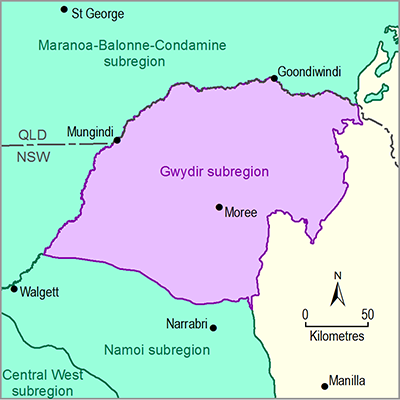- Home
- Assessments
- Bioregional Assessment Program
- Gwydir subregion
- 1.1 Context statement for the Gwydir subregion
- 1.1.4 Hydrogeology and groundwater quality
Groundwater monitoring is undertaken by the state government, being generally limited to the high-use alluvial aquifer systems and parts of the Surat Basin. While water levels are regularly monitored, information on groundwater quality is limited.
The main alluvial groundwater systems in the subregion are the Lower Namoi Alluvium, the Lower Gwydir Alluvium, the NSW Border Rivers Alluvium and the NSW Border Rivers Tributary Alluvium. Groundwater within these areas is contained in the Upper Narrabri Formation and the more productive, deeper Gunnedah Formation. In the deepest paleochannel of the Lower Namoi Alluvium, the Gunnedah Formation is underlain by the productive Cubbaroo Formation. Groundwater in these aquifers is dominantly recharged by stream losses, being generally fresh and supporting irrigation. However, water levels in some areas of the Lower Gwydir Alluvium and Lower Namoi Alluvium have been declining for several decades indicating that extraction is likely to have been occurring above sustainable levels. Water salinity has also increased in places. In the alluvium outside of these main groundwater sources, groundwater salinity reportedly increases and yields typically decrease.
Groundwater from the Surat Basin system that underlies the alluvial aquifers is mostly sourced from the Pilliga Sandstone in the subregion. Waters are generally fresh and suitable for town water, stock and domestic use, but a high sodium adsorption ratio typically renders Great Artesian Basin (GAB) waters unsuitable for irrigation. However, in the east of the subregion the Pilliga Sandstone outcrops at the surface and in this recharge area for the GAB, younger, higher quality water supports irrigation at North Star.
Hydraulic interaction between the overlying alluvial aquifers and underlying Surat Basin is impeded by low permeability confining units at the top of the Surat sequence and the widespread development of a deep saprolitic layer. However, in the deeper paleochannels inter-aquifer flow is possible, where hydraulic heads typically favour upward leakage from the Surat Basin (although this is not universally the case). There is some evidence to suggest that faults act as conduits for upward migration of groundwater to shallower systems in places (e.g. the Peel Fault in the Border Rivers area).
A very limited amount of hydrogeological information was identified during this study for the Gunnedah and Bowen basins. These basins appear to be poorly developed in the subregion due to the presence of shallower, high quality groundwater resources.
The volcanic rocks of the New England Tablelands and Nandewar Volcanic Field are not extensive in the subregion. Where present, they are anticipated to contain local flow systems with low salinity groundwater.

